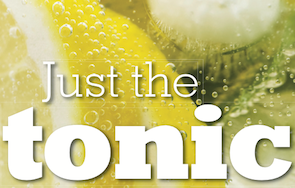THREE-QUARTERS is a commanding share of the whole. It’s a grade A on your maths paper, the controlling share of a business, and more than enough seats to govern a country. It’s also the proportion of T in a G&T – but here three-quarters commands only a small fraction of attention.
When it comes to the gin quarter of the equation, punters have become particularly particular. They want a brand, a style, premium packaging and enough botanicals to arouse a hippy. Some are even reassured by a £30 price tag – but then off-set the damage with an own-brand tonic. Better that than the gin, remains the pervading view.
In most pubs and bars, it’s not all that different. “Bombay and tonic,” says the punter. “Drowned in a mass-produced artificially-flavoured and sweetened tonic?” ought to be the reply. Except it isn’t, bartenders just unholster their bar gun and let the gin have it.
People say this is changing, that the few premium brands out there are bringing tonic into premium parity with gin.
Charles Rolls and Tim Warrillow’s Fever-Tree was, of course, the forerunner of swanky tonic and, since it launched in 2005, has been since joined by the likes of Global Premium Brands’ 1724 and Fentimans’ tonics.
Fever-Tree has offered the most stirring evidence that the premium message is getting through. Last year it sold 44 million of its 25cl bottles, which won’t be far short of 44 million G&Ts.
A development not unnoticed by investors – in March 49% of Fever-Tree shares were bought by LDC for £48m in exchange for more funding. Hardly the stuff of artisanal production, but Warrillow disagrees that corners will be cut. “Our investors have a significant minority and we remain in control. They understand the provenance of Fever-Tree and they do not want to compromise,” he says.
Compromise comes in many flavours but the use of sodium saccharine or aspartame is the most widely committed sin.
This is the route taken by the world’s biggest tonic brand, Schweppes, along with the likes of Britvic and supermarket own-brands (though not the UK’s Waitrose). According to Warrillow saccharine leaves a “nasty bitter back flavour” and is clear sign that brands are “more interested in cost engineering than flavour”.
There are also different philosophies on quinine, the necessary bitter taste we associate with tonic water. As apostle of provenance, Fever-Tree sources “the purest form of quinine in the world” from “just about the most lawless place in the world” in the eastern Congo.
Meanwhile, 1724 has literally gone the extra mile to source its quinine, climbing the Inca Trail to 1,724m above sea level as it does. As for the mainstreamers, quinine tends to be ambiguously listed under ‘flavouring’. G&J Greenall’s Joanne Moore is a good person to talk tonic. Not only does she make more gin than Bombay Sapphire would like to let on, she is based in the UK’s Warrington, where carbonated water was invented.




